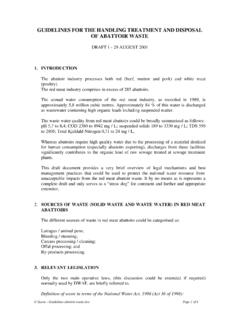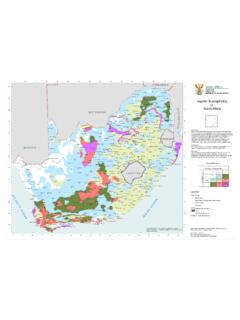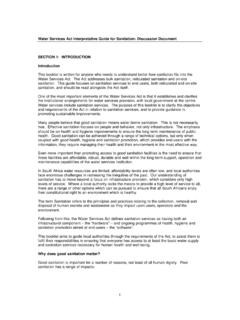Transcription of WHITE PAPER ON BASIC HOUSEHOLD …
1 WHITE PAPER . ON. BASIC HOUSEHOLD sanitation . 2001. TABLE OF CONTENTS. A INTRODUCTION ..4. Definitions ..5. B THE sanitation PROBLEM ..7. Overview of the Health problems associated with poor The environmental impacts of poor The economic cost of poor Social and psychological problems associated with poor sanitation ..9. C POLICY PRINCIPLES .. 11. Policy principles .. 11. D STRATEGIC INTERVENTIONS .. 13. Participation of 13. Promotion of health and hygiene awareness and 13. Development and use of local resources .. 14. Upgrading of existing facilities .. 15. The adoption of an integrated environmental management approach 15.
2 Adoption of a common approach to implementation .. 16. Specific programmes to clear the backlog .. 18. Target date for clearing the backlog .. 18. Prioritise communities with the greatest need .. 18. Develop plans to address the sanitation problem .. 19. Institutional, funding and monitoring 19. E INSTITUTIONAL ARRANGEMENTS .. 20. Constitutional responsibilities .. 20. The roles and responsibilities of municipal government .. 20. The roles and responsibilities of provincial government .. 21. The roles and responsibilities of National Government .. 22. The roles and responsibilities of the Department of Water Affairs and Forestry.
3 22. The roles and responsibilities of the Department of Provincial and Local 23. The roles and responsibilities of the Department of 23. The roles and responsibilities of National 24. The roles and responsibilities of the Department of Housing .. 24. The roles and responsibilities of the Department of 24. The roles and responsibilities of the Department of Public Works .. 25. The roles and responsibilities of the Department of Environmental Affairs and Tourism .. 26. The private 26. Non-governmental organisations .. 26. Coordination mechanisms .. 27. 2. WHITE PAPER on BASIC HOUSEHOLD sanitation F THE FUNDING OF sanitation IMPROVEMENT.
4 28. Sources of funding for sanitation 28. Equitable Share subsidy .. 28. Infrastructure grants and the requirement for 28. Municipalities own revenue .. 29. The housing 30. The Integrated Development Plan as an interim integrating mechanism for the alignment of funding .. 31. G ..MONITORING AND EVALUATION OF THE IMPLEMENTATION OF THIS. 33. Key performance indicators .. 33. Crisis reporting .. 33. Computer systems .. 34. H CONCLUSION AND THE WAY FORWARD .. 35. APPENDIX A sanitation TECHNICAL OPTIONS. 3. WHITE PAPER on BASIC HOUSEHOLD sanitation A INTRODUCTION. Introduction Providing adequate sanitation facilities for the poor remains one of the major challenges in all developing countries.
5 An estimated eighteen (18) million South Africans or three (3) million households do not have access to adequate sanitation facilities. Those who have inadequate sanitation may be using the bucket system, unimproved pit toilets or the veld. In addition there is a disturbing increase in poorly designed or operated water-borne sewerage systems, especially in urban areas. When sanitation systems fail, or are inadequate, the impact on the health of the community, on the health of others and the negative impact on the environment can be extremely serious as witnessed by the million cases annually of diarrhoea in children under the age of 5 and the recent outbreaks of cholera.
6 Inadequate sanitation facilities and infrastructure combined with unhygienic practices represent South Africa's sanitation problem. The unhygienic practices are clearly the results of: - lack of health and hygiene awareness;. - lack of sanitation facilities - inadequate water supplies;. - poor facilities for the safe disposal of waste water and other domestic waste; and - inadequate toilet and hand washing facilities. The WHITE PAPER on Water Supply and sanitation Policy published in November 1994 highlighted the importance of establishing a national sanitation policy. In response to the WHITE PAPER , a draft National sanitation WHITE PAPER was published in 1996.
7 Even though the draft WHITE PAPER was never formally approved it was the first time that a national sanitation policy had been prepared which addressed the needs of all South Africans. This National sanitation Policy improves on the initial attempts in 1996 to produce a WHITE PAPER and incorporates the knowledge gained in actual implementation of the sanitation improvement programmes since then. Purpose Government has a constitutional responsibility to ensure that all South Africans have access to adequate sanitation . The publication of this national 4. WHITE PAPER on BASIC HOUSEHOLD sanitation sanitation policy is an important step in the process of meeting this responsibility and in addressing the problems of inadequate sanitation .
8 The purpose of this policy document is to: - highlight the impact of poor sanitation on health, living conditions and the environment;. - articulate government policies on sanitation ;. - provide a basis for the formulation of local, provincial and national sanitation improvement strategies aimed at addressing the backlog;. - provide a framework for municipality driven implementation programmes;. - promote greater coherence and co-ordination amongst the different spheres of government and amongst other role players in addressing the sanitation problem;. - ensure that sanitation improvement programmes are adequately funded; and - put in place mechanisms to monitor the implementation of this policy and sanitation improvement programmes so that corrective action can be taken when necessary.
9 This policy focuses specifically on the provision of a BASIC level of HOUSEHOLD sanitation to mainly rural communities and informal settlements. These are the areas with the greatest need. This policy also deals with the need for an environmentally sound approach to providing sanitation services and addresses the need to protect surface and ground water resources from sanitation pollution through integrated environmental management practices. Definitions In the past, sanitation has been seen primarily as a technical issue (toilet building, providing sewer systems, maintenance etc.) whilst other aspects have been given secondary consideration.
10 It is now recognised that toilets are just one element in a range of factors that make up good sanitation . Community participation in decision-making, improved health of millions of people, safer living environments, greater knowledge of sanitation -related health practices and improved hygiene are just some of the factors that are central to the development of good sanitation services. For the purpose of this policy it is necessary to define sanitation and also to give guidance on the minimum acceptable BASIC level of sanitation : sanitation refers to the principles and practices relating to the collection, removal or disposal of human excreta, HOUSEHOLD waste water and refuse as they impact upon people and the environment.
















